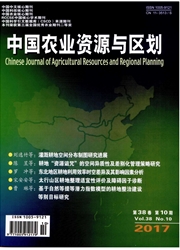

 中文摘要:
中文摘要:
耕地物候的空间格局综合反映了作物种植在环境因子及人类活动双重作用下的空间差异性,因此耕地物候识别成为农业遥感应用的热点之一。研究利用SPOT的植被指数产品开展我国北方耕地作物种植制度空间分布的遥感识别并分析耕地种植制度空间分布特征。首先使用非对称高斯函数拟合法对时间序列植被指数进行重构,然后采用多项式和谐波函数拟合数据来确定耕地的生长季个数,最后通过比例阈值法提取耕地的生长季开始期和结束期。在上述过程中结合先验知识引入波峰阈值并通过对NDVI时间序列数据进行"掐头去尾"处理来保证耕地种植制度识别以及物候信息获取的准确性。基于SPOT/VGT数据对我国北方15省的耕地种植制度进行了识别,并在此基础上分别提取了不同生长季的耕地物候信息并分析了其空间格局特征。结果表明,适当引入先验知识有利于正确识别耕地种植制度和准确获取耕地物候信息,2005年我国北方耕地的种植制度以一年一熟为主,一年二熟制主要分布在北纬40°以南的平原地区。其中第一生长季的空间格局差异比第二生长季更加明显,同时生长季结束期分布的时间范围比开始期更为集中。总之我国北方耕地物候的空间格局与种植制度密切相关,受到自然资源和人类活动的共同影响。
 英文摘要:
英文摘要:
Spatial patterns of cropland phenology synthetically reflect the spatial differences of agricultural farming under governance of both environmental factors and human activities on the cropland.Thus,identification of cropland phenology has been a hot topic in applications of remote sensing to agriculture.In this study we intend to examine the cropland phenology in Northern China using the SPOT/VGT product.We start with data preparation in which the original NDVI time-series for cropland of the study area are reconstructed by Asymmetric Gaussian function fitting method.Then we use the peaks of the polynomial and harmonic combined function fitted curves to identify the number of growing seasons.Finally the onset of growth and end of growth dates for cropland of the study area are derived using a NDVI threshold method.During the above procedures we introduced priori knowledge by using a NDVI peak value threshold and removing some data in the NDVI time series to ensure the accuracy of cropping system identification and phenology detection.Cropping systems in Northern China are determined based on the reconstructed NDVI time-series from SPOT/VGT and the spatial patterns are investigated for the first and second growing season respectively.The results showed that appropriate introduction of priori knowledge can help to identify the cropping system and detect the cropland phenology accurately.For Northern China single cropping system was dominate,areas of double cropping system probably moved to the south of 40°N.Differences of spatial patterns for the first growing season were much more significant than the second growing season.The distribution time range for the end of growth date was more concentrated than the onset of growth date.In general,spatial patterns of cropland phenology in Northern China were closely related to the cropping systems,which were influenced by both natural resources and human activities.
 同期刊论文项目
同期刊论文项目
 同项目期刊论文
同项目期刊论文
 Perspective of Chinese GF-1 high-resolution satellite data in agricultural remote sensing monitoring
Perspective of Chinese GF-1 high-resolution satellite data in agricultural remote sensing monitoring 期刊信息
期刊信息
